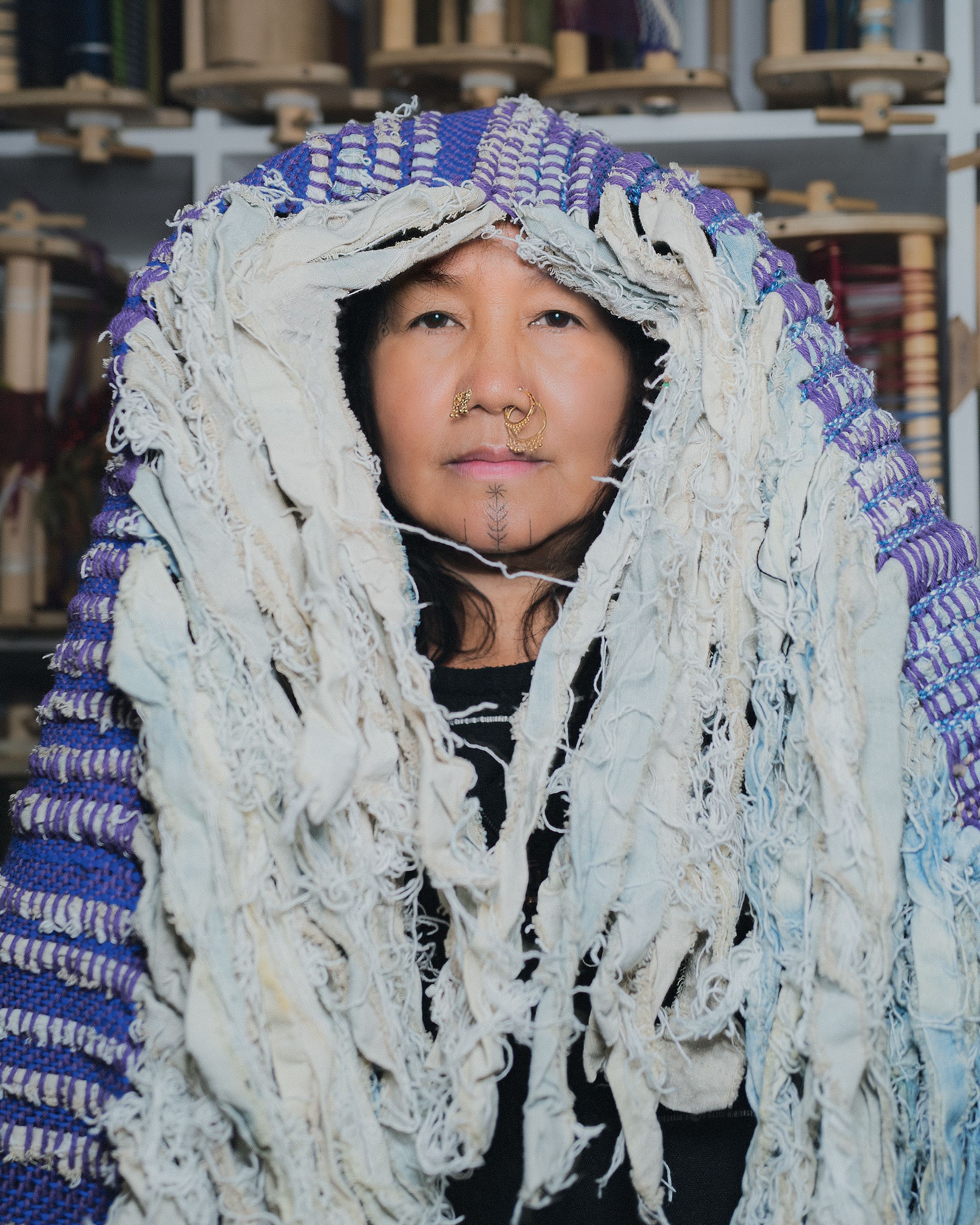Photo by Lawrence Sumulong
Thread by thread, weaver and artist Cynthia Alberto finds her way home.
Midway through our Zoom interview, weaver artist Cynthia Alberto dons a llama mask with faux fur and glass eyes, her laughter trilling through the latex and the fiber optic lines that connect us through the thousands of miles that separate New York City from Manila.
Cynthia wore the mask in performance art shows called “The Weaving Llama” in 2019 and 2020. In one of them, the sound of Cynthia’s clicking loom and an ancestral sarunay from Mindanao were interlaced with piano and electronic keyboard melodies. The following year, Cynthia took her llama alter ego and loom outdoors, where she wove colorful fabrics, banged on a drum instrument, and danced on a street corner in Queens to engage the local community.
Her works are inspired by traditional processes of weaving from the world over: Latin America, Asia, Africa, and Europe, while using unorthodox materials such as human hair that she used in an anting-anting project during her artist residency at the Museum of Arts and Design (MAD) in New York in 2018, and scrap fabrics she uses to support her zero
waste philosophy.
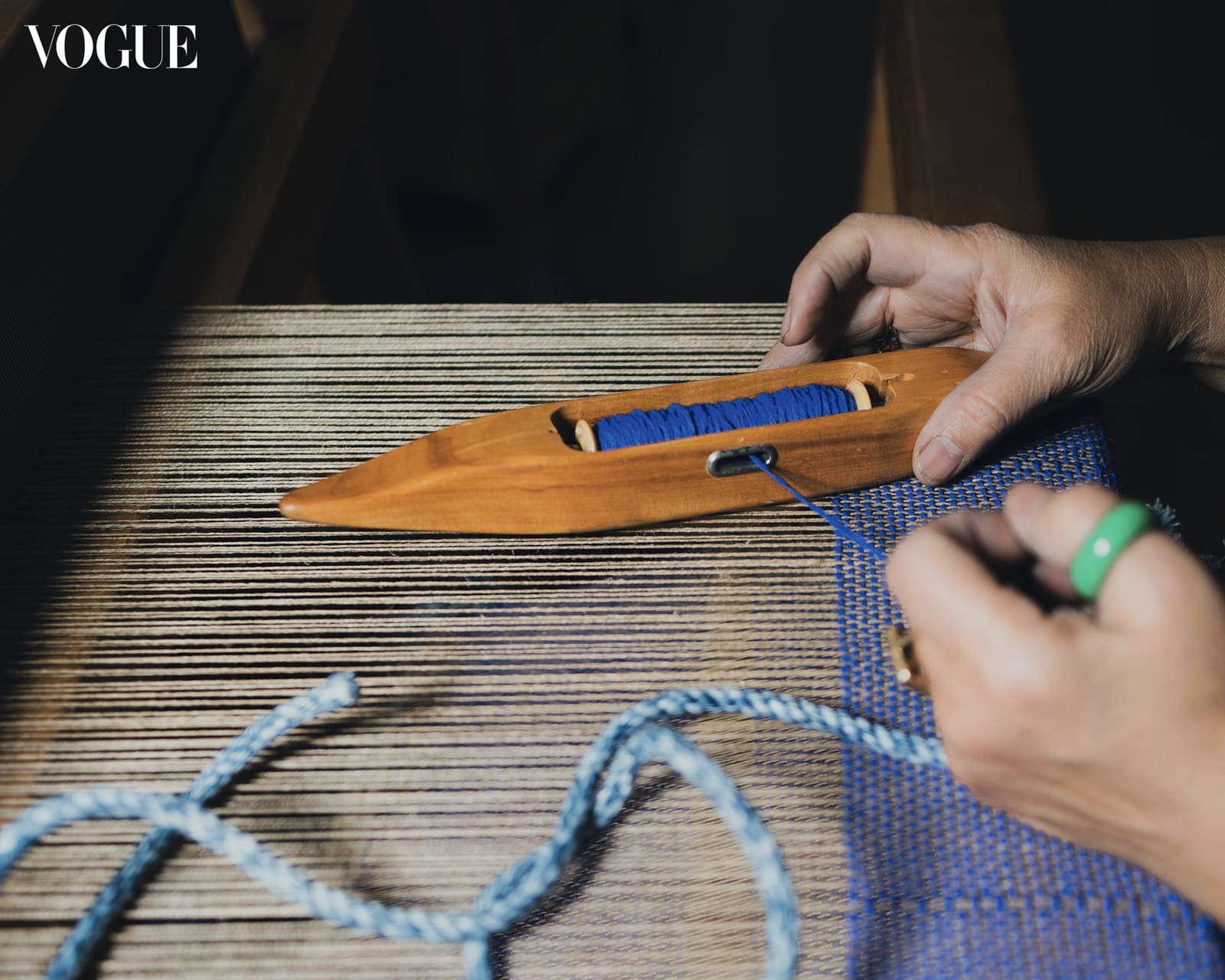
Cynthia has led “Weaving Together” events at MAD, Cooper Hewitt, Barnard College, Pratt Institute, and the Queens Museum in New York, among others.
Without the llama mask, her untamed hair tumbles over her shoulders and arms, one inked with bold tattoos. She wears a 21-carat gold nose ring from Nepal—she has five of them, she says—that mark milestones in her life, her divorce, for one; the death of her mother, for another. Ink also adorns her chin and temples, motifs from textiles from her mother’s home province of Nueva Ecija.
Cynthia is the founder of Weaving Hand, a studio and healing arts center in Park Slope, Brooklyn she founded in 2006 while she herself was hurting at the end of her marriage. She teaches different types of weaving classes, conducts after school programs for children, and healing classes for adults with disabilities.
“Weaving calms your mind, helps you focus, due to the repetitive movement, back and forth. The class provides a social atmosphere since people weave together, interact together, developing personal relationships,” says Cynthia. “Weaving has immediate results, as you can take home the cloth you make in class. People love touching the yarn, it’s very soft, very tactile. It’s comforting, it relaxes them.”
“Weaving is leading me back home.”
Cynthia was born in the Philippines and reminisces about growing up with her grandparents and siblings on a farm in Novaliches.
“I remember farmers plowing the fields with carabaos, and us climbing trees and eating mangoes. Beautiful memories,” she says.
But images she tried so hard to obliterate remain buried in her head, shards of painful recollections of being left behind by their mother, an accountant, who left for the U.S. when her youngest brother was but two months old, to seek their proverbial fortune. Their father, who worked in an automobile factory, followed two years later.
“That was the immigrant way back then, I know, but I still felt abandoned,” she says.
Five years after their mother left, the children rejoined their parents in the United States, where Cynthia did her best to assimilate. She followed the path of her parents in pursuing the American dream, studying computer science and getting a job with Merrill Lynch on Wall Street.
She embraced Western culture, attempted to mask her Filipino accent, and dated white men.
“I was really fully immersed in becoming accepted as an American,” she says. “It was the ’80s and there was this Asian fetishization going on, and I was a young woman trying to figure out my identity.”
Once, while in Paris, a woman who recognized her as Filipino called her a “dogeater.” She denied her heritage and declared she was Chinese. Her disavowal gnawed at her conscience for years, and it was only years later that she realized she had been masking her identity as a result of colonization.
One day Cynthia saw an ad for an opening in sales at the Village Voice, and moved from Wall Street to the East Village counterculture. There she met Filipino American writer and New York University professor Luis Francia, who chided her for being ashamed of her Filipino heritage.
“I told him, ‘I don’t know, and it’s none of your business.’ But now I’m in a whole different place. I have a different understanding of myself. I can go back to my younger self and really see where I came from.”
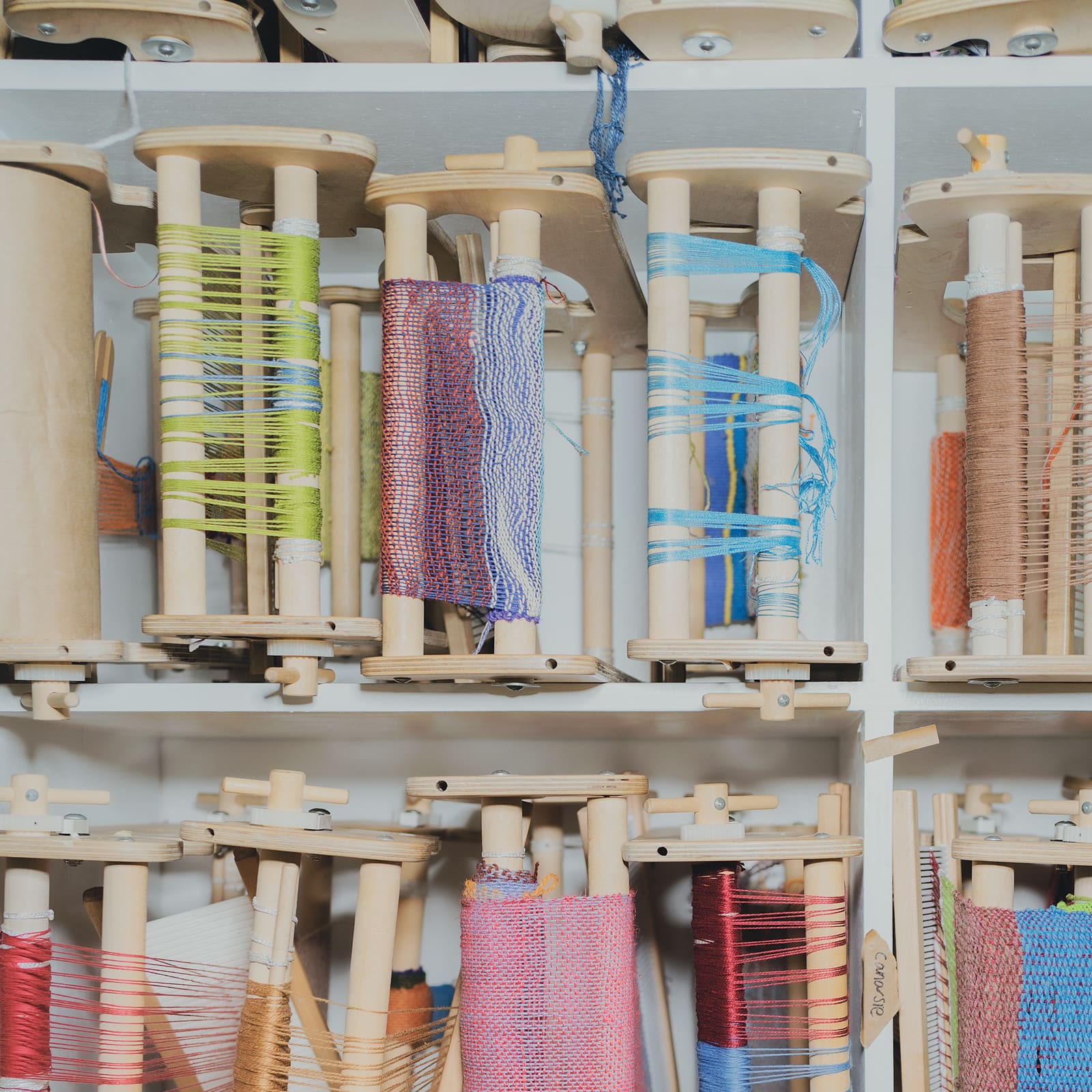
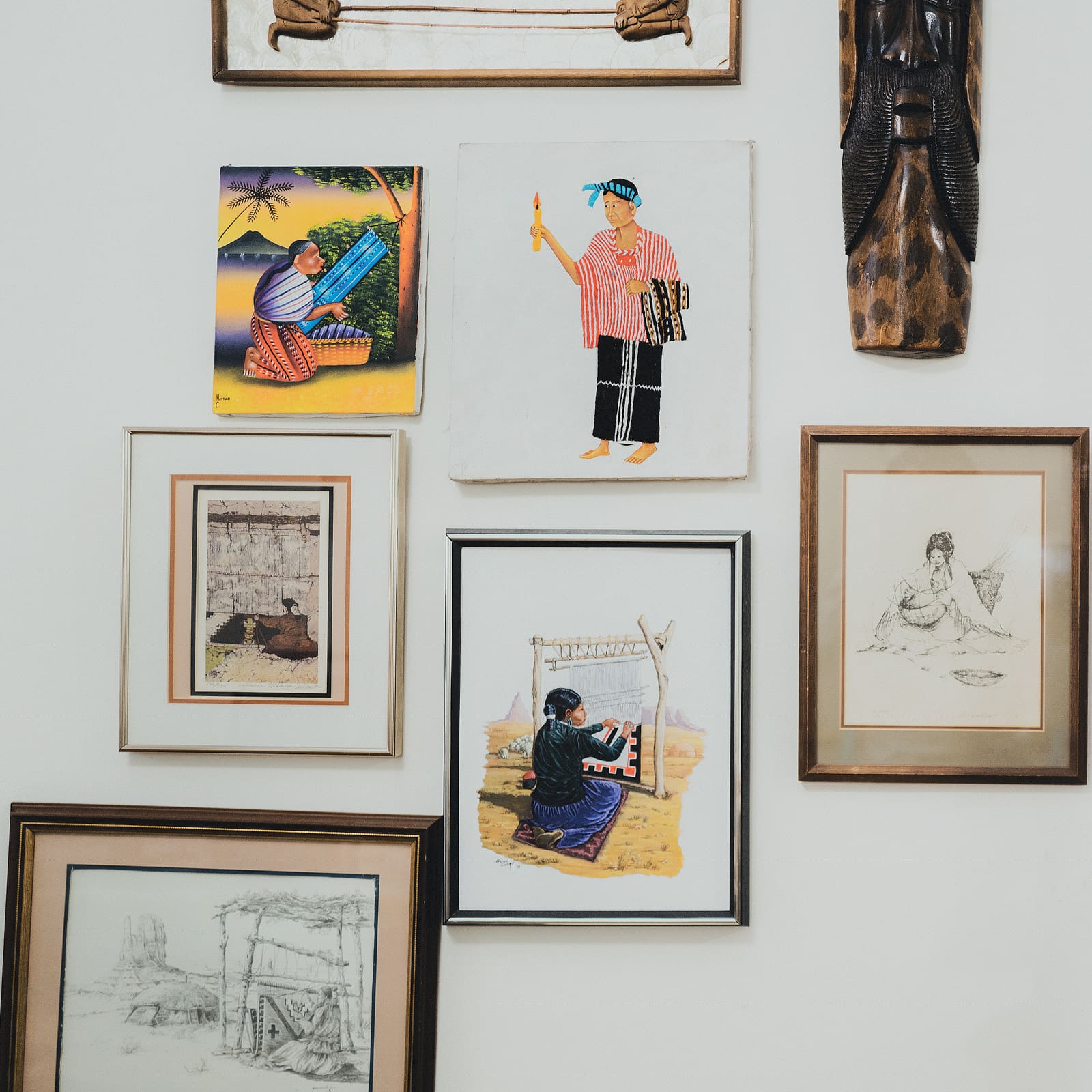
Cynthia eventually left her sales career and went back to college, enrolling at the Fashion Institute of Technology, majoring in textile surface design. While there, she learned Tibetan rugmaking, and later, explored Guatemala and Nepal to learn their traditional processes.
When her children were in their teens, they began questioning Cynthia about their heritage, trying to decipher their emotions, and that’s when she began sorting out her own as well.
“’What are we?’ they asked. ‘We’re half Russian Jew and half Filipino, but we don’t know anything about the Philippines except its food,’” Cynthia says. “They were questioning their identity. And then suddenly, it was like a switch that clicked. A decolonization. My children opened the door and reconnected me with my being Filipino. Now we have a whole different mindset. It’s an ongoing process of learning about race, gender, and identity that doesn’t stop.”
At her Brooklyn studio, she gathers Filipinos for “kainan and usapan” as she calls it. They talk about their memories of the Philippines and discuss “who we are and what are we doing here?”
“It doesn’t happen all the time but when it does, it’s beautiful,” she says.
Cynthia says weaving has been a way of connecting with different communities, including Filipinos with a shared history. She recently gave a big weaving workshop that brought together Filipino immigrants in Hawaii.
She also does outreach programs with children in less privileged neighborhoods whom she knows need to take a break from their electronic devices.
“The kids love it, doing something else with their hands, the idea of making a cloth. They reconnect with the basics. It’s like wondering, ‘where does our food come from?’ In this case, it’s ‘where does the clothing that covers us come from?’” says Cynthia.
As an artist, Cynthia is currently working on the Llama Book Project, a color and tintype photography book, in collaboration with photographer Edmond Yu.
In May, she will be doing an artist residency at the Haystack Mountain School of Crafts in Maine. Later this year she will be showing works and a big weaving together activation at a group show at the Southeastern Center for Contemporary Art (SECCA), an affiliate of the North Carolina Museum of Art.
Also on her schedule is a solo exhibition next year at the Patricia Sweetow Gallery in Los Angeles that will feature backstrap looms.
After her show, she plans to finally return to the land of her birth for the first time since she left almost half a century ago, practically a whole lifetime. She plans to apply for a Fulbright scholarship, so she can learn the art of weaving traditional Filipino textiles, as well as to really get to know the weavers and their culture.
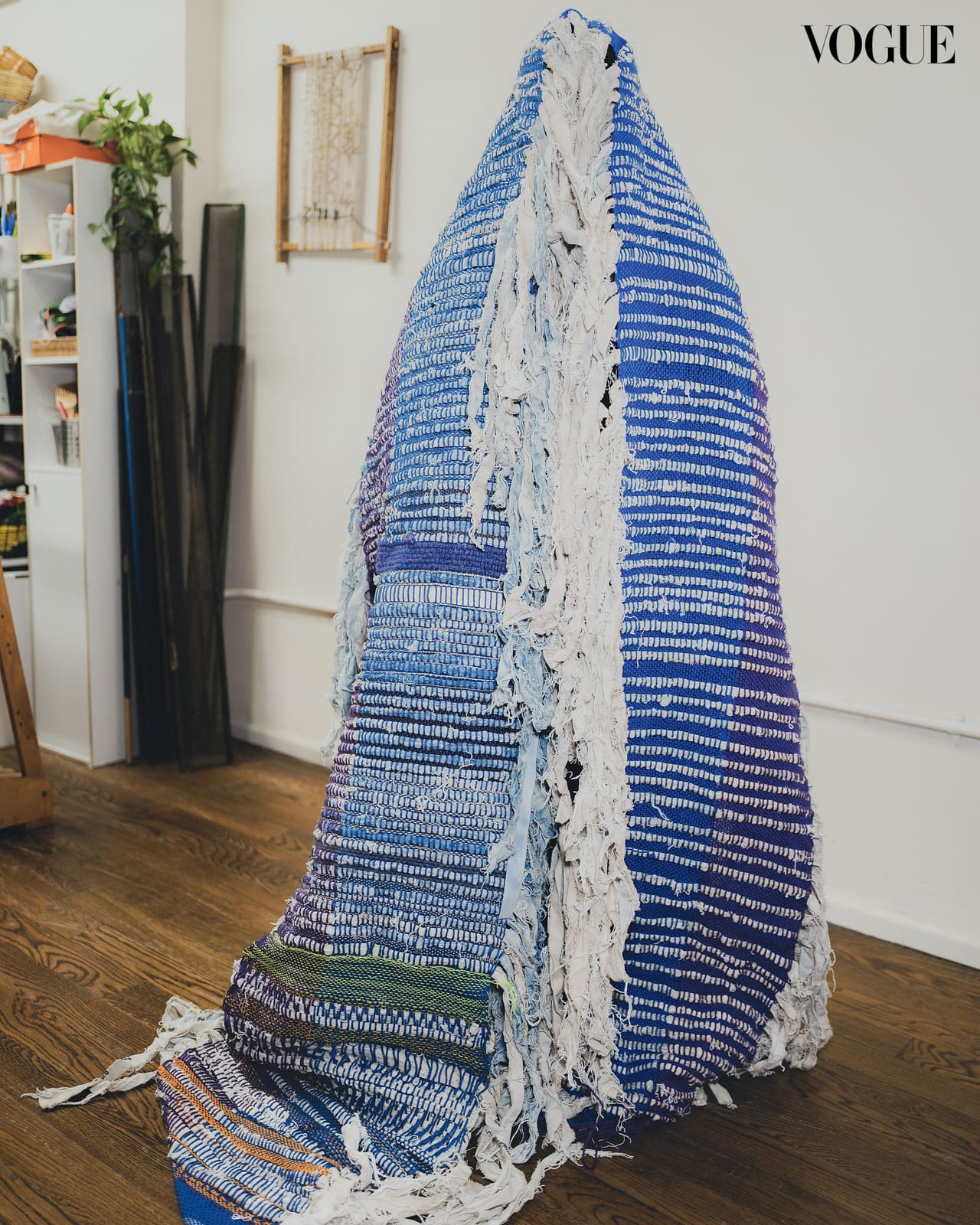
“I’m anxious at the thought of going home. There were the beautiful memories of my grandparents and my cousins and the farm, but then there was also the trauma for many years of being left behind. I was also so ashamed back then because of how I’d pretended I wasn’t Filipino when that woman called me a dogeater. That shame ran deep, so many layers,” says Cynthia.
“But I’m ready now. I’m in the right place and have the mindset to do it. I’m ready to go back and embrace it now. Weaving is leading me back home.”
